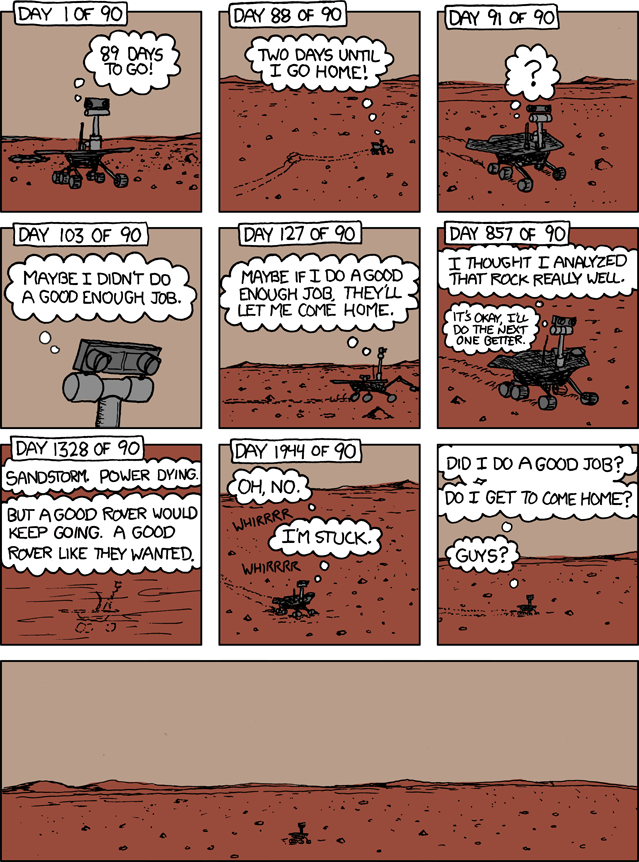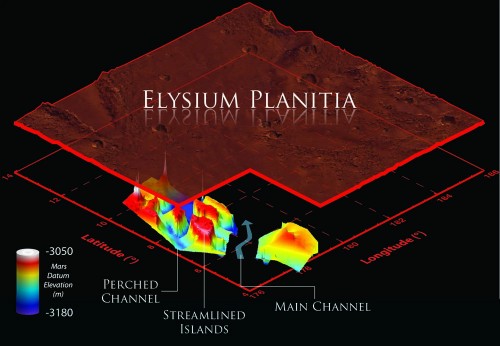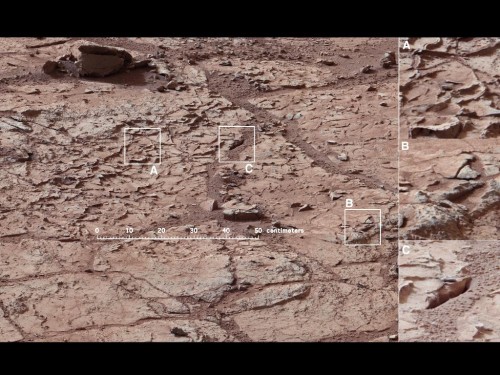Tag archives: Mars
Life on Mars?

Magic mushroom? (Courtesy: NASA)
By Michael Banks
You may remember the story of Walter Wagner, the Hawaii resident who set his sights on stopping CERN’s Large Hadron Collider (LHC).
Wagner, together with his colleague Luis Sancho, filed a federal lawsuit in the US District Court in Honolulu in 2008 to prevent the LHC from starting up. In the lawsuit, Wagner and Sancho claimed that if the LHC were switched on, then the Earth would eventually fall into a growing micro black hole, thus converting our planet into a medium-sized black hole, around which the Moon, artificial satellites and the International Space Station would orbit.
View all posts by this author | View this author's profile
Safe graphene, Martian mollycoddling, mathematical tales and more
By Tushna Commissariat
Just when we thought that it couldn’t possibly have any more practical applications, everybody’s favourite “wonder material” graphene is going to be used to develop “stronger, safer, and more desirable condoms”. Thanks to a Grand Challenges Explorations grant of £62,123 from the Bill and Melinda Gates Foundation, scientists at the University of Manchester will use graphene to develop new “composite nanomaterials for next-generation condoms, containing graphene”. Unsurprisingly, the story made all the national newspapers with the BBC, the Guardian, the Telegraph and the Independent all having their say. The Guardian also noted that industrial graphene-producer Applied Graphene Materials’ shares jumped by 40% during its stock-market debut, the day before the above story broke. You can read more about graphene’s many potential applications on page 50 of Physics World’s anniversary issue, a free PDF download of which is available here.
View all posts by this author | View this author's profile
Islands in a Martian stream
By Hamish Johnston
A very long time ago, a large amount of water is thought to have flowed on the surface of Mars – and the above image shows what scientists think is an ancient Martian river channel that has been buried by volcanic material.
View all posts by this author | View this author's profile
60 Second Adventures in Astronomy
By Hamish Johnston
If you are a fan of astronomy and the comedian David Mitchell, the Open University has a treat for you. Mitchell and the OU have made a series of 12 short animated videos about the physics of the cosmos.
View all posts by this author | View this author's profile
Curiosity on Mars
By Michael Banks in Boston
John Grotzinger, project scientist for NASA’s Curiosity mission, might be best known for whipping up a media frenzy in late November when he told NPR that data from one of the probe’s 10 instruments was “gonna be one for the history books”.
While the news that the probe had discovered evidence of organic molecules in the soil but more tests were needed was less than earth shattering, today at the 2013 AAAS meeting in Boston, Grotzinger gave an update on the mission that touched down on Mars on 6 August 2012.
If you don’t fancy reading any more, the bottom line is that everything is working as expected.
View all posts by this author | View this author's profile
Atlantis lifts off into history
By Tushna Commissariat
Despite gloomy weather conditions that threatened to cancel the launch altogether, NASA’s shuttle Atlantis has launched from the Kennedy Space Center. Marking the last and final flight of the Space Shuttle Programme – STS-135 – Atlantis and a four-person crew are on a 12-day mission to deliver more than 3.5 tonnes of supplies to the International Space Station (ISS). This final stock should keep the station running for a year. Although the countdown stopped briefly at 31 s before the launch, the shuttle had a “flawless” lift-off, according to NASA. It has now settled down into its preliminary orbit ahead of its rendezvous with the ISS this Sunday morning.
The image above is of the shuttle, taken shortly after the rotating service structure was rolled back yesterday at Launch Pad 39A at the Kennedy Space Centre in Florida (Credit: NASA/Bill Ingalls). Below is an image of the mission patch for this final iconic flight (Credit: NASA).

“The shuttle’s always going to be a reflection of what a great nation can do when it commits to be bold and follow through,” said astronaut Chris Ferguson, commander of the mission, from the cockpit of Atlantis minutes before the launch. “We’re completing a chapter of a journey that will never end. Let’s light this fire one more time, and witness this great nation at its best.”
Atlantis was the fourth orbiter built and had its maiden voyage on 3 October 1985. Atlantis had a number of firsts to its name – it was the first shuttle to deploy a probe to another planet, to dock to the ISS and the first with a glass cockpit! It conducted a final servicing mission to the Hubble Space Telescope in May 2009.
NASA has decided to retire its shuttle programme with this last flight because the vehicles are too costly to maintain. It now intends to contract out space transport to private companies. The hope is that this will free NASA resources to invest in a other programmes that will potentially send humans beyond the space station to the Moon, Mars and maybe even asteroids.
Atlantis is also carrying some rather unusual passengers – some simple yeast cells. The aim is to study the yeast cells as their genetic make up is remarkably similar to that of a human cell. This makes it an ideal system for studying genetic defects and understanding how these defects may manifest in human disease. In two separate experiments – conducted at the ISS – researchers will study the effect of microgravity on cell growth.
The video below has the crew of Atlantis talking about the “vibrancy of the ISS as a stepping stone for NASA’s plans for future human exploration beyond low Earth orbit”.
View all posts by this author | View this author's profile
Goodnight, Spirit

The “Spirit” comic strip on the xkcd.com webcomic (Credit: Randall Munroe/Creative Commons)
By Tushna Commissariat
The long and tumultuous journey for NASA’s Mars rover Spirit has finally come to an end, as the space agency’s engineers have ended attempts to regain contact with the vehicle, which has been out of touch since 22 March 2010. Now, Spirit’s twin, Opportunity, will explore the red sands solo until the arrival of younger brother Curiosity – NASA’s third rover, set to be launched in November.
The end of the road for Spirit came yesterday, when NASA engineers made a final and unsuccessful attempt to contact the rover. They had hoped that Spirit might rejuvenate as the solar energy became available once more, after a rather cold and dreary Martian winter without much sunlight. But without enough energy to run its survival heaters, the rover likely experienced colder internal temperatures last year than in any of its previous six years on Mars, possibly causing critical internal damage.
“Our job was to wear these rovers out exploring, to leave no unutilized capability on the surface of Mars, and for Spirit, we have done that,” says Mars Exploration Rover Project manager John Callas of NASA’s Jet Propulsion Laboratory in Pasadena, California.
Spirit landed on Mars on 3 January 2004 for what was planned as a three-month mission. After accomplishing its primary objectives, Spirit went on to explore a distance of 7.7 km, almost 12 times its initial goal. Spirit became the first robot to climb to the summit of a hill on another planet; and covered more than half a mile after its right-front wheel became immobile in 2006. Over time, it sent home more than 124,000 images, looked at 92 samples of soil and rock and unexpectedly discovered silica deposits in the Martian soil when it upturned soil due to a dragging back wheel. This was, ironically, one of the biggest discoveries made by a rover to date.
“What’s most remarkable to me about Spirit’s mission is just how extensive her accomplishments became,” enthuses Steve Squyres of Cornell University, Ithaca, a principal investigator for Spirit and Opportunity. “What we initially conceived as a fairly simple geologic experiment on Mars ultimately turned into humanity’s first real overland expedition across another planet. Spirit explored just as we would have, seeing a distant hill, climbing it and showing us the vista from the summit. And she did it in a way that allowed everyone on Earth to be part of the adventure.”
Just in case you are about to shed a tear, you might enjoy the above image that Randall Munroe, a former physicist who is now behind the popular xkcd.com webcomic, drew sometime last year when contact was lost with the rover. A rather touching and prophetic image, he brings out the human side of our robot geologist.
View all posts by this author | View this author's profile



